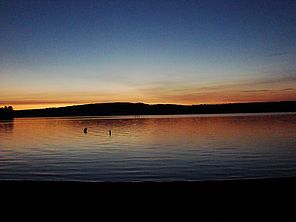Sunrise Sunset
December 2012

One of the great joys of living near Lake Champlain is the breath-taking sunrises or sunsets one can see over the water. Colors can range from a crisp red to a blend of pastel hues, from pink to baby blue, shifting even over the course of the event. Why is it that dawn and dusk lend such a visual explosion to the sky while mid-day colors range merely from blue through gray?
Pure light is white. For us to perceive color the white light must be separated into its constituent wavelengths, referred to as scattering. Blues and violets have shorter wavelengths while reds and oranges are longer. Two different types of scattering play a role in determining sky color: Rayleigh scattering and Mie scattering.
When light waves run into particles smaller than their wavelength it is referred to as Rayleigh scattering. The phenomenon was named for British physicist John Strutt otherwise known as Lord Rayleigh. Particles that cause Rayleigh scattering include air molecules. In the absence of an atmosphere the sky would appear black, as it does in pictures from the moon. Rayleigh scattering disproportionately affects low wavelength light – blues and violets which is why our sky is blue (water molecules also cause Rayleigh scattering which is why pure water appears blueish). If our eyes were more like those of bees and could better detect violet, we would see even more of that color in the sky.
When light runs into particles slightly larger than its wavelength it is referred to as Mie scattering, named for the German physicist Gustav Mie. Particles that cause Mie scattering include water droplets, smoke, smog, and particulates. Mie scattering affects all wavelengths of light so the reflected image is white. Mie scattering is responsible for the white of clouds in an otherwise blue sky and the hazy look of high humidity days.
The two types of scattering are not exclusive. At any given time the colors we observe in the sky result from a combination of Mie and Rayleigh scattering. When Rayleigh scattering predominates, a sunset produces crisp bright colors. When Mie scattering occurs, we see more pastels and softer colors. Thus, clean air produces brightly colored sunrises and sunsets while dusts and various aerosols subdue color.
Within the sky one can sometimes see a gradation from pale blue near the horizon to bright blue high in the sky. This observation reflects the decreasing importance of Mie scattering at higher altitudes. The heavier particles that cause Mie scattering are thickest closer to the earth. Thus, when you look at the horizon, you are looking through more particles than when you look straight up.
So where do the reds and oranges of the sunset come from? At dusk and dawn light must travel through more of the atmosphere, because of the low position of the sun. This leads to even more scattering and the only colors remaining by the time the light hits your eye are the reds. The effect intensifies as the sun nears the horizon. Blues and yellows morph into reds and oranges as the light passes through a thicker atmospheric layer leading to the shifting color scheme through a sunrise or sunset.
Reds and oranges are also reflected off of clouds, which play a critical role in the brilliance of any sunset. The ideal cloud for a brilliant sunset sits high enough to intercept sunlight that has not been filtered through too many atmospheric layers. So, wispy horsehair cirrus clouds and high cotton ball cumulus clouds produce better sunsets than low-lying sheets of stratus clouds.
Some of the best sunset conditions occur when there is a small layer of clear sky between the horizon and a layer of higher clouds. Passing weather fronts can create such conditions, meaning they mark a transition point between clear skies and cloudy. If the transition occurs in the morning with the sun in the east, it suggests more clouds are on the way as moisture moves eastward. If the transition occurs in the evening with the sun in the west, it suggests skies will be clearing as the front moves on. Hence the old saying “Red sky at night, sailors’ delight. Red sky in the morning, sailors’ take warning.”
Another factor making Lake Champlain sunrises and sunsets so impressive is the juxtaposition of mountains and lake. The lake provides a reflection of the brilliant colors of the sky. The mountains offer various shades of blue as a further complement. Mountains appear blue because they are in the distance so they are illuminated by Rayleigh scattered light. If you are able to observe multiple ranges at the same time, the ones furthest away should appear bluest.
If you can stand the cold, winter sunsets can be more brilliant than summer. Humidity is much lower in the winter. Cold air can carry less water than warm air. Additionally, the photochemical reactions that generate smog are less likely to occur at lower temperatures. Both of these factors lead to less Mie scattering. Still, at any time of year the area’s sunrises and sunsets are worth savoring. (For a more complete explanation of the physical forces that color sunsets, check out the writing of Stephen Corfidi from NOAA)
Lake Look is a monthly natural history column produced by the Lake Champlain Committee (LCC). Formed in 1963, LCC is the only bi-state organization solely dedicated to protecting Lake Champlain’s health and accessibility. LCC uses science-based advocacy, education, and collaborative action to protect and restore water quality, safeguard natural habitats, foster stewardship, and ensure recreational access.
Get involved by joining LCC using our website secure form (at www.lakechamplaincommittee.org), or mail your contribution (Lake Champlain Committee, 208 Flynn Avenue - BLDG 3 - STUDIO 3-F, Burlington, VT 05401), or contact us at (802) 658-1414, or lcc@lakechamplaincommittee.org for more information.
